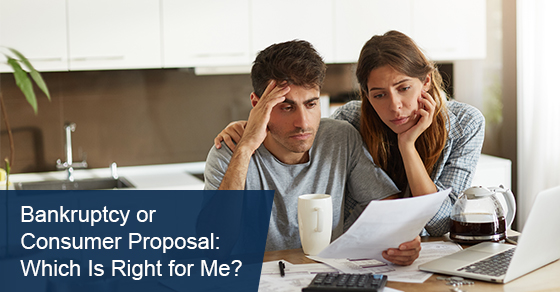As Canadians grapple with financial instability, many are forced to re-examine their finances to ensure their survival and secure their future amidst this turmoil.
Unemployment benefits and social assistance, lines of credit, and emergency savings are designed to assist with precarious financial situations. Despite these, many people in Ontario continue to risk unemployment, lose their homes, run the risk of bankruptcy, and require consumer proposals to navigate their financial situation.
If you find yourself in a state of insolvency, it’s important to remember that you have options — and these can make all the difference in helping you recover and return to a solid financial footing.
The question is, which insolvency option is right for you? Learn the difference between personal bankruptcy and consumer proposals, and make an informed choice that secures your financial future:
Bankruptcy vs. Consumer Proposal: Quick Facts
Some debt is normal: whether it’s your monthly credit card statement, car payments, or a mortgage, it is unavoidable but manageable with regular payments as long as your income is stable and supports your expenses.
Debt becomes a problem — and requires relief through insolvency options — when your financial situation changes so drastically, so much that you can no longer afford these regular payments. Unfortunately, because debt is an obligation, you may face legal action enforced by creditors.
Debt relief options like bankruptcy and consumer proposals exist to help you avoid these dire legal consequences, offer a “financial reset,” and a path back towards solvency. These two differ in how they handle your debt.
A bankruptcy filing requires liquidating or surrendering some non-exempt assets to creditors to eliminate debts. In contrast, a consumer proposal allows you to keep your assets with lower monthly payments.
A Closer Look at Filing for Bankruptcy
In simplest terms, going bankrupt means being unable to afford financial obligations, including debt payments and even regular living expenses.
Short of facing legal action enforced by creditors, a bankruptcy filing presents you with a tradeoff: deal with the value of your non-exempt assets for creditors to relieve you of your debts. This legal process is managed by a Licensed Insolvency Trustee who monitors your compliance with bankruptcy duties.
Aside from dealing with your non-exempt assets, a bankruptcy filing requires attending crediting counselling sessions and filing monthly reports on your income and expenses. These are designed to help you get a handle on your finances and ensure that your remaining obligations are settled through residual monthly payments proportionate to your income. Once these duties are complete, you could be discharged from bankruptcy within 9 to 21 months.
What Is a Consumer Proposal?
Consumer proposals are an alternative debt relief solution. This is a formal agreement that you enter with your creditors, and like bankruptcy, is managed by a Licensed Insolvency Trustee who will help you negotiate the terms of debt repayments.
When you enter into a consumer proposal, you will be required to pay part or all of your unsecured debt with a value of less than $250,000 at a reduced rate over a specified period.
A consumer proposal guarantees that your debts are settled at a rate that you can handle. This agreement protects you from debt collectors and wage garnishments, especially as interest stops accumulating upon filing.
Consumer Proposal vs. Bankruptcy — Which Is Better?
Both debt relief solutions are designed to help you overcome insolvency and return to financial security. However, they differ in how they handle debt relief and settlement, especially in terms of asset repossession or surrender and fixed payments.
Bankruptcy filings are much more severe than consumer proposals. Aside from requiring asset surrender, monthly bankruptcy payments are determined by your income, which puts you at a disadvantage if your income is expected to increase.
Consumer proposals do not require asset surrender and instead settle outstanding debts through predictable, fixed payments. Further, while a bankruptcy stays on your financial record for six years and impacts your credit score significantly, a consumer proposal only affects your credit rating for three years, to a lesser extent.
Monthly Reporting and Payments
Both debt relief solutions require the fulfillment of monthly duties. In the case of bankruptcy, your monthly reporting and responsibilities consist of payments proportionate to your income.
You will also be required to submit a monthly budget for expenses and provide your Licensed Insolvency Trustee with a copy of your pay stubs. These financial documents will establish the payment amount and determine whether you need to make surplus income payments.
Consumer proposals are a lot less stringent and reactive to changes in your financial situation. Unlike a bankruptcy filing, there are no monthly reporting tasks, and you do not need to inform the trustee of changes to your income.
Monthly payments are also easier to accommodate since these remain fixed for the duration of the agreement and do not change when your financial situation shifts. Essentially, consumer proposals are more affordable in the long run.
Credit Score While in Debt Relief
A bankruptcy filing severely impacts your credit score — it indicates that you are a bad loanee, so much that you were previously unable to keep up with debt obligations and require rehabilitation to return to solvency. When you claim bankruptcy, you will be assigned an R9 credit score — the lowest rating — and will remain on your credit history for 7 to 14 years.
In contrast, consumer proposals are a lot less severe, meriting a slightly better R7 rating that indicates you have entered into a fixed repayment settlement. This rating only remains for three years after you complete payments or six years after you file.
Filing Taxes While in Bankruptcy or Consumer Proposal
Since your tax information provides a snapshot of your financial situation in a year, significant developments like a bankruptcy filing or consumer proposal need to be documented.
However, when you file for bankruptcy in Ontario, you will lose all eligible tax refunds or credits you were owed since these are considered part of your assets. In contrast, a consumer proposal allows you to claim tax refunds and credits.
Bankruptcy vs. Consumer Proposal: Choose the Best Option
Deciding between these two debt relief solutions comes down to your specific financial situation. While consumer proposals allow you to retain your assets, and require fixed payments, they appear to favour many people with assets.
However, the best choice is not clear-cut: a Licensed Insolvency Trustee can examine your case and help determine the most viable option based on your surplus income, assets owned, and the total amount of debt owed.
Declaring bankruptcy may or may not be the best option for you as it comes at the cost of your non-exempt assets and eligible tax credits. In contrast, the terms of a consumer proposal are easier to manage and are based on what you can afford to pay. It’s essential to determine your eligibility and consult with a Licensed Insolvency Trustee to choose between the two.
For more information about consumer proposals and declaring bankruptcy, call Kevin Thatcher & Associates at 1-888-329-5198, or contact us here.


